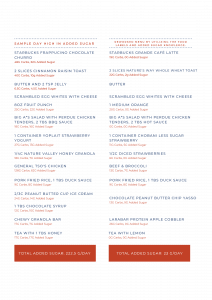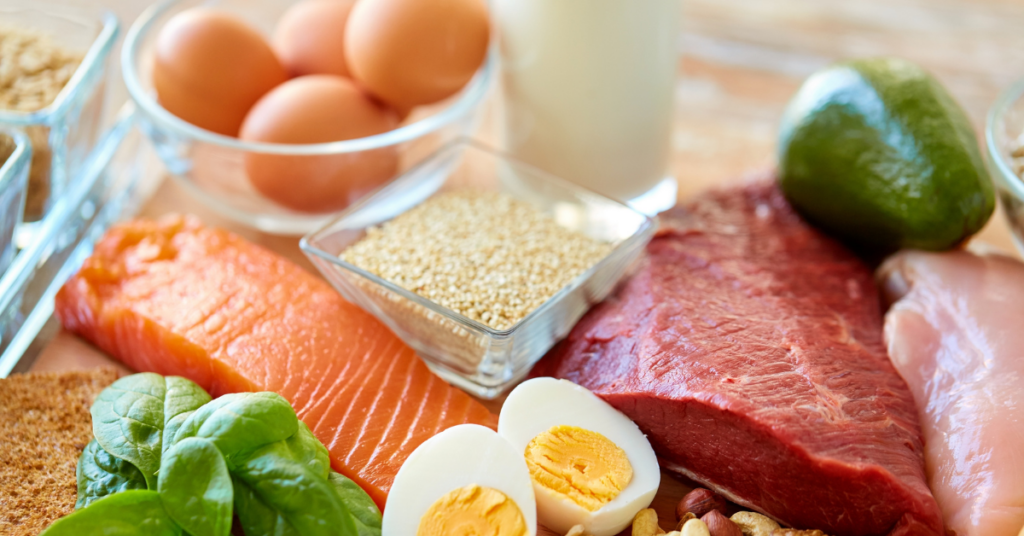By: Katie Leahy
RDN, Stronger U Coach
Did anybody else grow up eating pop rocks, full-sized candy bars, fun dip, and chomping on big league chew (bubble gum) regularly? Even my popcorn of choice was cracker jacks. My dad owned a pizzeria with a wall-sized shelf full of all types of candy, cakes, sodas, and that much enjoyed Yoo-hoo.
It was a part of my weekday routine for over a decade to get picked up from school, head to work with my dad until my mom picked me up a few hours later with pretty much full reign to any food/sweets/beverages a kid could dream of. Added sugar certainly wasn’t a concern of the ’90s (unlike the low-fat craze) or really until recently. But now, there’s a lot more research backing up the crucial role added sugar can play for all of us and our long-term health.
As you may know, Stronger U exists to help change the way the world thinks about food. This article does not relate sugar intake to weight loss or gain but offers another way to promote being proactive and supporting overall health and wellness. Establishing an awareness is a huge piece to this as many individuals consume more sugar than they realize. Whether you are an expert about sugar or just starting to understand the role that natural and added sugars play in our diets, this article will be your go-to guide and resource for making informed decisions about your sugar intake.
What is Added Sugar?
There are two types of sugar in our diet, natural or added. As defined by the American Heart Association, naturally occurring sugars are found naturally in foods such as fruit (fructose and glucose) and milk (lactose).
Added sugars are sugars and syrups put into foods during preparation or processing or added at the table. Other names for added sugar include but are not limited to sucrose, dextrose, table sugar, syrups (yes maple too), high fructose corn syrup, molasses, cane sugar, corn sweetener, raw sugar, honey, and sugars from concentrated fruit or vegetable juices. Added sugars, just like fat, enhance the palatability of the foods we eat. They also support our food looking better after cooking, and can improve certain foods texture/mouth-feel, which makes us keep coming back for more. Added sugars are in most foods; look at table 1 to see if any of these subtle sugar sources surprise you!
Top 3 Sources of Added Sugar in the US diet:
- Sugar-sweetened beverages: soft drinks, coffee, energy drinks & certain juices
- Desserts: cookies, cakes, brownies, pies, ice cream
- Sweet snacks: sweetened dairy, donuts, sweet rolls, pastries, cereal, granola bars, flavored waffles
Recommended Intake
The Dietary Guidelines for Americans 2020-2025 recommend that for ages 2 years and older added sugar intake should be less than 10% of one’s total daily caloric intake. To make the math easy (for me), this means that someone following a 2,000 kcal/day diet, should be aiming for 200 calories or less from added sugars. This would be the equivalent of about 12 teaspoons. For those that need fewer calories per day also means they need less added sugar intake per day. You might be thinking, “that’s not fair!”! But if you think about it, the fewer calories coming from added sugar in your diet, means perhaps that more calories are available to come from nutrient-dense, satiety-supporting food sources. Basically, if you’re eating less sugar, you’re leaving more room for foods that will fill you up and keep you satisfied longer.
Similarly, The American Heart Association offers a blanket statement recommendation of fewer than nine teaspoons or 150 calories per day for men, and less than six teaspoons or 100 calories per day for women of added sugars.
Current Consumption
According to the 2020-2025 U.S Dietary Guidelines report, added sugars are contributing on average to 270 kcal/day or 13% of total daily caloric intake. This percentage is equal to 17 teaspoons of sugar per day, or double the recommended intake.
Added Sugar Can Increase Health Risks
Recent research is now recognizing excess added sugar intake as a risk factor for obesity, prediabetes, type 2 diabetes, and cardiovascular disease. To emphasize, excess sugar does not cause diabetes or any other chronic disease by itself. But when consumed in excess, it is now being recognized as an additional controllable risk factor for increasing the risk of disease. The main objective is to bring an added awareness and application to your own added sugar intake.
Sugar in Your Diet
For an assignment in graduate school, we were asked to track our added sugar intake. I was no stranger to reading food labels, but calculating added sugars was not on my mind. Without mentioning how many years ago this task was, at that time the food label only listed sugars. Whereas now, the most updated food label includes added sugars. Why does this matter? Previously if you were to look at an 8oz container of white milk, the nutrition label listed total carbohydrates, 13g; sugars 13g. So it was often assumed white milk was a source of added sugar. With today’s updates, the same label for an 8oz carton of milk reads, 13g carbs, 13g sugar, 0g added sugar.
Why does this Matter?
As the consumer, the added sugar piece on the food label offers us additional information and feedback to make more informed decisions for not only ourselves but our family/friends too on which products we want to buy and consume.
Personally, when I have a choice between a product such as cereal with 20g added sugar per 1 cup, versus a cereal with only 7g added sugar per 1 cup, I will always choose the lower added sugar version. It really allows us to take a closer look and make these decisions ourselves. Transparency for once!
Side note: My Fitness Pal and some other popular food trackers still only list sugars under the nutrient list. This can be confusing as many members reach out to me concerned by their sugar intake is too high or flagged. More often than not when we take a closer look together at the food logs, it’s easy to see that MFP is counting all sugars, naturally occurring ones like fruit and milk. Boo!
Have you ever tracked your own added sugar intake? Were you surprised with your intake amount? If not, you may have underestimated your intake. Did you know that added sugar is in so many foods and beverages these days and the residual effect is felt around the world? Pasta sauce, soup, pizza, coleslaw, Chinese food, yogurt, condiments such as ketchup or BBQ sauce. The list goes on! Even if you don’t drink soda, take your coffee black, and don’t have a sweet tooth, you may still be consuming more sugar than you think.
If you were wondering what my average added sugar intake was when I tracked it many moons ago, it was 22 teaspoons per day. YIKES. And I didn’t drink soda, flavored coffees, or add sugar to my foods (including condiments). But I sure do have a sweet tooth.
Time to apply!
I challenge you to track your added sugar intake for the next three days, including one weekend day. Aren’t you curious? Since most trackers still only list sugars and not added sugars, this is a task for post-it notes and a pencil. Yes, by hand. It’s only 3 days. Take a look at the two following examples of a high sugar day and a low sugar day. Notice how quickly sugar adds up (even when you’re being mindful about not eating sweets!).

The Sweeter Way to Reduce Sugar in Your Diet
Are you ready to reduce the added sugar in your diet? After reading through this article you might be feeling like it’s a big mountain to climb, are you unsure of where to begin? When I coach members, I offer them six suggestions to start their journey to reducing their sugar consumption. Here are my top tips for shaking sugar:
- Identify your current added sugar intake and attempt to reduce it by half.
- Compare food labels and choose options with the lowest amounts of added sugar.
- Consider when/where/how you add sugar to things and reduce the frequency and portion size of these sources.
For example, adding maple syrup to protein pancakes, a flavored creamer to coffee, a quick breakfast on-the-go flavored instant oatmeal, or higher sugar cereal. Reduce or replace.
- Avoid sugar-sweetened beverages.
- Reduce the amount of sugar called for within a recipe (I do this all the time with my sweet cornbread, muffin, and brownie recipes, with no noticeable difference in taste)
- Eat that fruit!! Please! It’s worth the carbs aka natural sugars and gives so much back to us!
Nobody is the Food Police
If you were to ask anyone who knows me they would likely tell you that some of my favorite things to eat involve chocolate or ice cream. I have gone so far as to self-proclaim myself as a dietitian with a sweet tooth and a smile, for good reason. While it is all about balance, I understand the addictive factor added sugars can have but now have a heightened awareness of how they can put me at increased risk towards my already well-known familial factors for CVD. I, the dietitian, still have to constantly remind myself to limit intake in moderation and to be fully aware of where my added sugars are coming from. Because I mean, peanut butter and chocolate is there anything better?!
Here at Stronger U, we encourage our members to find balance in the foods that they love while still supporting their fitness and nutrition goals. Recent research has shown us that added sugar increases the risk of chronic illness and weight gain, but to live rich lives, we must learn how to create a balance of enjoying desserts, delicious foods, and yes, added sugar. If you are looking for more direction on creating a sustainable change in your own diet, consider signing up for a session with a Stronger U coach. During these coaching sessions, we can support you in identifying sneaky sugar and promoting a more well-balanced plan that still leaves room for even a Yoo-hoo once in a while.








